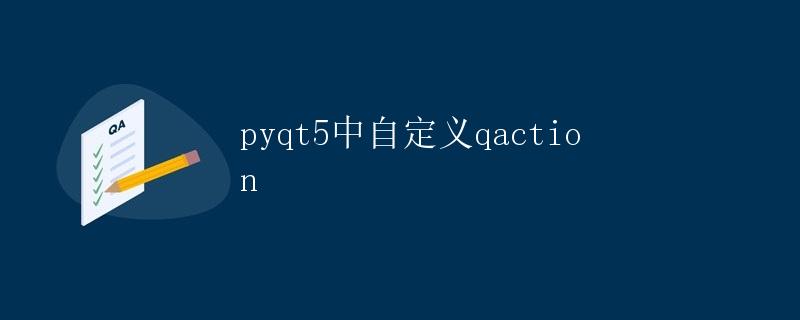PyQt5中自定义QAction

在PyQt5中,QAction是一个用于菜单栏、工具栏和快捷键的动作。通常,我们会使用预定义的QAction来实现常见的功能,但有时候我们需要自定义QAction以满足特定的需求。在本文中,我们将详细解释如何在PyQt5中自定义QAction。我们将学习如何创建自定义的QAction,并将其添加到菜单栏和工具栏中。
创建自定义QAction
首先,我们需要导入所需的模块和类:
from PyQt5.QtWidgets import QAction
然后,我们可以创建一个自定义的QAction。以下是一个简单的示例:
custom_action1 = QAction('Custom Action 1', self)
custom_action2 = QAction('Custom Action 2', self)
在上面的示例中,我们创建了两个自定义的QAction,分别命名为”Custom Action 1″和”Custom Action 2″。
接下来,我们可以为这些QAction添加一些属性和行为。例如,我们可以为它们设置快捷键、工具提示和连接的槽函数。下面是一个示例:
custom_action1.setShortcut('Ctrl+1')
custom_action1.setToolTip('This is Custom Action 1')
custom_action1.triggered.connect(self.custom_action1_triggered)
custom_action2.setShortcut('Ctrl+2')
custom_action2.setToolTip('This is Custom Action 2')
custom_action2.triggered.connect(self.custom_action2_triggered)
在上面的示例中,我们为每个自定义的QAction设置了快捷键、工具提示以及连接的槽函数。当触发这些QAction时,相应的槽函数将被调用。
将自定义QAction添加到菜单栏和工具栏
一旦我们创建了自定义的QAction,我们可以将它们添加到菜单栏和工具栏中。以下是一个示例:
file_menu = self.menuBar().addMenu('File')
file_menu.addAction(custom_action1)
file_menu.addAction(custom_action2)
toolbar = self.addToolBar('Custom Actions')
toolbar.addAction(custom_action1)
toolbar.addAction(custom_action2)
在上面的示例中,我们首先创建了一个菜单栏,并将自定义的QAction添加到一个名为”File”的菜单中。然后,我们创建了一个工具栏,并向其添加了相同的自定义QAction。
运行上述代码后,我们会在应用程序的菜单栏和工具栏中看到我们创建的两个自定义QAction。当我们点击这些QAction时,相应的槽函数将被调用。
完整示例代码
以下是一个完整的示例代码,演示了如何创建和使用自定义的QAction:
import sys
from PyQt5.QtWidgets import QApplication, QMainWindow, QAction
class CustomActionExample(QMainWindow):
def __init__(self):
super().__init__()
custom_action1 = QAction('Custom Action 1', self)
custom_action1.setShortcut('Ctrl+1')
custom_action1.setToolTip('This is Custom Action 1')
custom_action1.triggered.connect(self.custom_action1_triggered)
custom_action2 = QAction('Custom Action 2', self)
custom_action2.setShortcut('Ctrl+2')
custom_action2.setToolTip('This is Custom Action 2')
custom_action2.triggered.connect(self.custom_action2_triggered)
file_menu = self.menuBar().addMenu('File')
file_menu.addAction(custom_action1)
file_menu.addAction(custom_action2)
toolbar = self.addToolBar('Custom Actions')
toolbar.addAction(custom_action1)
toolbar.addAction(custom_action2)
self.setWindowTitle('Custom Action Example')
self.show()
def custom_action1_triggered(self):
print('Custom Action 1 Triggered')
def custom_action2_triggered(self):
print('Custom Action 2 Triggered')
if __name__ == '__main__':
app = QApplication(sys.argv)
window = CustomActionExample()
sys.exit(app.exec_())
在上面的示例中,我们创建了一个名为”Custom Action Example”的窗口,并向其添加了两个自定义的QAction。当我们点击这些QAction时,相应的槽函数将输出相应的消息。
结论
在PyQt5中,自定义QAction可以帮助我们实现特定的功能和定制化需求。通过创建自定义的QAction,并将其添加到菜单栏和工具栏中,我们可以丰富我们的应用程序界面,提升用户体验。
 极客教程
极客教程